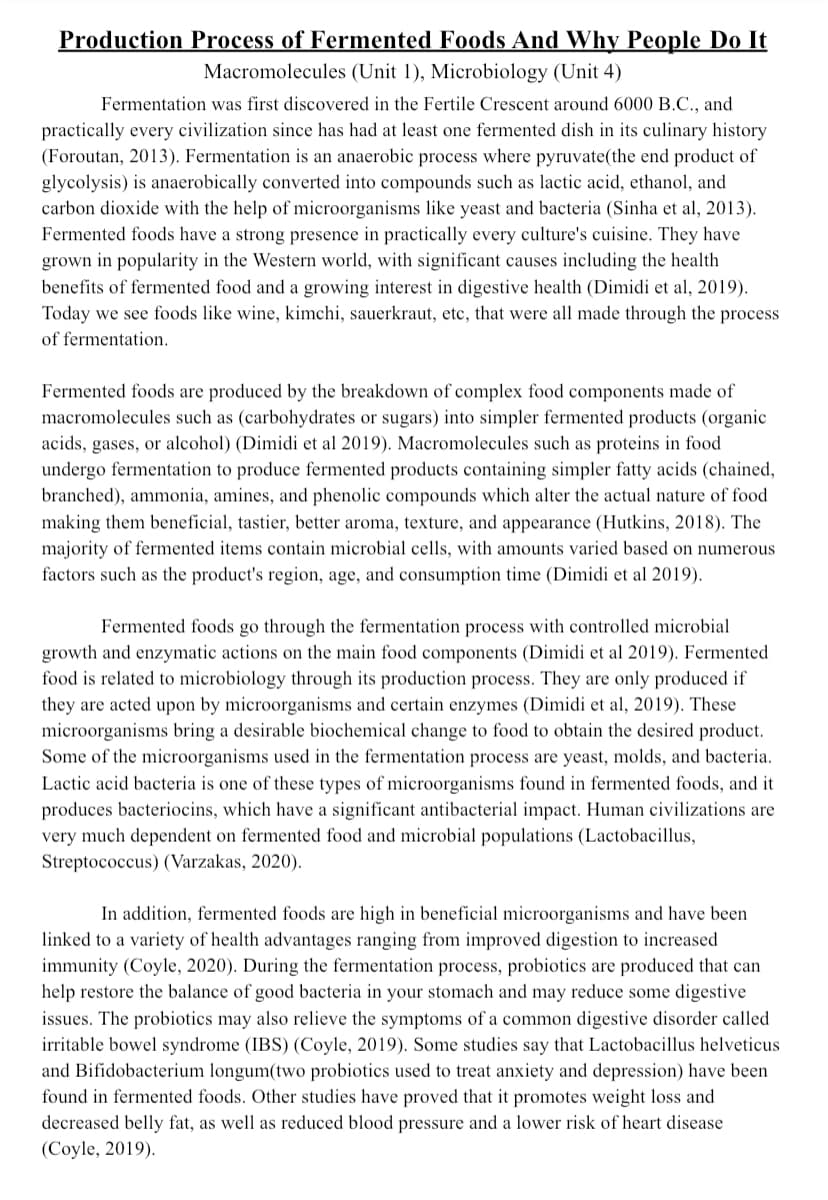Hi! Can you read over my essay and correct/add anything that I need? It’s supposed to connect fermented food to the topic of Microbiology and Macromolecules.
Hi! Can you read over my essay and correct/add anything that I need? It’s supposed to connect fermented food to the topic of Microbiology and Macromolecules.
Biochemistry
6th Edition
ISBN:9781305577206
Author:Reginald H. Garrett, Charles M. Grisham
Publisher:Reginald H. Garrett, Charles M. Grisham
Chapter18: Glycolysis
Section: Chapter Questions
Problem 5P
Related questions
Question
Hi! Can you read over my essay and correct/add anything that I need? It’s supposed to connect fermented food to the topic of Microbiology and Macromolecules.

Transcribed Image Text:Production Process of Fermented Foods And Why People Do It
Macromolecules (Unit 1), Microbiology (Unit 4)
Fermentation was first discovered in the Fertile Crescent around 6000 B.C., and
practically every civilization since has had at least one fermented dish in its culinary history
(Foroutan, 2013). Fermentation is an anaerobic process where pyruvate(the end product of
glycolysis) is anaerobically converted into compounds such as lactic acid, ethanol, and
carbon dioxide with the help of microorganisms like yeast and bacteria (Sinha et al, 2013).
Fermented foods have a strong presence in practically every culture's cuisine. They have
grown in popularity in the Western world, with significant causes including the health
benefits of fermented food and a growing interest in digestive health (Dimidi et al, 2019).
Today we see foods like wine, kimchi, sauerkraut, etc, that were all made through the process
of fermentation.
Fermented foods are produced by the breakdown of complex food components made of
macromolecules such as (carbohydrates or sugars) into simpler fermented products (organic
acids, gases, or alcohol) (Dimidi et al 2019). Macromolecules such as proteins in food
undergo fermentation to produce fermented products containing simpler fatty acids (chained,
branched), ammonia, amines, and phenolic compounds which alter the actual nature of food
making them beneficial, tastier, better aroma, texture, and appearance (Hutkins, 2018). The
majority of fermented items contain microbial cells, with amounts varied based on numerous
factors such as the product's region, age, and consumption time (Dimidi et al 2019).
Fermented foods go through the fermentation process with controlled microbial
growth and enzymatic actions on the main food components (Dimidi et al 2019). Fermented
food is related to microbiology through its production process. They are only produced if
they are acted upon by microorganisms and certain enzymes (Dimidi et al, 2019). These
microorganisms bring a desirable biochemical change to food to obtain the desired product.
Some of the microorganisms used in the fermentation process are yeast, molds, and bacteria.
Lactic acid bacteria is one of these types of microorganisms found in fermented foods, and it
produces bacteriocins, which have a significant antibacterial impact. Human civilizations are
very much dependent on fermented food and microbial populations (Lactobacillus,
Streptococcus) (Varzakas, 2020).
In addition, fermented foods are high in beneficial microorganisms and have been
linked to a variety of health advantages ranging from improved digestion to increased
immunity (Coyle, 2020). During the fermentation process, probiotics are produced that can
help restore the balance of good bacteria in your stomach and may reduce some digestive
issues. The probiotics may also relieve the symptoms of a common digestive disorder called
irritable bowel syndrome (IBS) (Coyle, 2019). Some studies say that Lactobacillus helveticus
and Bifidobacterium longum(two probiotics used to treat anxiety and depression) have been
found in fermented foods. Other studies have proved that it promotes weight loss and
decreased belly fat, as well as reduced blood pressure and a lower risk of heart disease
(Coyle, 2019).
Expert Solution
This question has been solved!
Explore an expertly crafted, step-by-step solution for a thorough understanding of key concepts.
Step by step
Solved in 2 steps

Knowledge Booster
Learn more about
Need a deep-dive on the concept behind this application? Look no further. Learn more about this topic, biology and related others by exploring similar questions and additional content below.Recommended textbooks for you

Biochemistry
Biochemistry
ISBN:
9781305577206
Author:
Reginald H. Garrett, Charles M. Grisham
Publisher:
Cengage Learning

Biochemistry
Biochemistry
ISBN:
9781305577206
Author:
Reginald H. Garrett, Charles M. Grisham
Publisher:
Cengage Learning